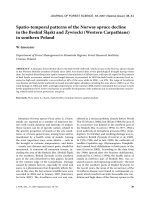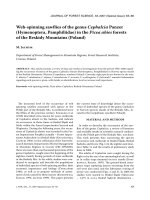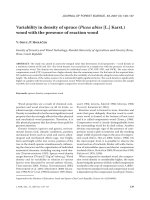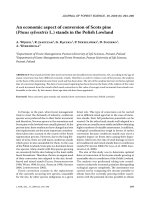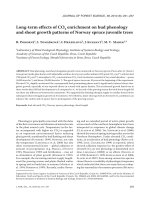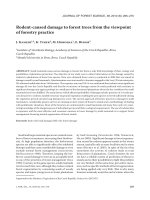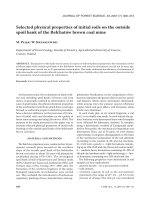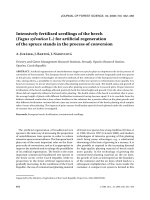Báo cáo lâm nghiệp: " Selected physical properties of initial soils on the outside spoil bank of the Bełchatów brown coal mine" pot
Bạn đang xem bản rút gọn của tài liệu. Xem và tải ngay bản đầy đủ của tài liệu tại đây (200.68 KB, 6 trang )
308 J. FOR. SCI., 53, 2007 (7): 308–313
JOURNAL OF FOREST SCIENCE, 53, 2007 (7): 308–313
At the present time, the reclamation of lands with-
out soil, including spoil banks of brown coal strip
mines, is generally confined to reforestation. In the
case of spoil banks, the physicochemical properties
of the overburden rocks from which their covering is
formed, as well as the proper reclamation procedure,
have a decisive influence on the processes of forma-
tion of initial soils, and therefore on the quality of
forest sites coming into being (S 1958). e
purpose of the study presented in this paper was to
estimate selected physical properties of initial soils
forming on the outside spoil bank of the Bełchatów
brown coal mine.
MATERIAL AND METHODS
e field investigations were conducted on 55 per-
manent research plots located on the northern
slope of the outside spoil bank of the Bełchatów
brown coal mine in about 20-years-old plantations
established during 1978–1981. The investigated
spoil bank is built of Quaternary and Tertiary sands
(65%), Quaternary loams and mudstones (20%), and
Tertiary clays (15%). During 1977–1982, after the
formation of the northern fragment of the slope,
biological treatments of reclamation were carried
out. ey included the introduction of herbaceous
vegetation, planting of trees, and also basic and sup-
plementary fertilization. In the composition of her-
baceous vegetation the grasses (fescue and rye-grass)
and legumes (white clover and lupine) dominated,
while among trees the pioneer species (Robusta
poplar, black and gray alders, and European white
birch) were dominant.
In each study plot, in its central fragment, a soil
pit (1 m in depth) was made. In each soil pit the ge-
netic horizons were determined from which samples
were collected for laboratory analyses. In samples,
using a hydrometric method of Casagrande modi-
fied by Prószyński, the mechanical composition was
determined. en, out of 55 plots, 10 were chosen
representing 3 categories distinguished on the basis
of the mechanical composition of the soil substrate
(according to the content of silt and clay fractions,
Ø < 0.02 mm), namely: a – light formations contain-
ing up to 10% of silt and clay (loose and coarse sands),
b – medium-heavy formations containing 10–20% of
silt and clay (medium sands – light and strong), c – hea-
vy formations containing over 20% of silt and clay.
e following properties were determined in soil
samples (in four replications):
– particle density – by a pycnometric method,
– bulk density,
– retention capacity of soil as the soil moisture
potential in the range of pF* 2.0 – pF 4.2 in the
process of drying (*the unit pF was introduced
Selected physical properties of initial soils on the outside
spoil bank of the Bełchatów brown coal mine
M. P, W. K
Department of Forest Ecology, Faculty of Forestry, Agricultural University of Cracow,
Cracow, Poland
ABSTRACT: e purpose of the study was to assess, in respect of selected physical properties, the reclamation of the
northern slope of the outside spoil bank of the Bełchatów brown coal mine by reforestation carried out 20 years ago.
Investigations were carried out on 55 permanent research plots. is study confirmed the efficiency of reclamation of
strip-mine spoils, and its results allowed to point out the properties of initial soils as the most useful characteristics for
the assessment of land reclamation by reforestation.
Keywords: forest reclamation; spoil bank; initial soils
J. FOR. SCI., 53, 2007 (7): 308–313 309
by Schofield in 1935 and it is the logarithm of the
negative pressure exerted by the water column.
Also other units are in use: kPa, cm H
2
O, J/m
3
).
Determinations were carried out in the low and
high pressure chambers on plates 1 bar, 5 bar, and
15 bar produced by Eijkelkamp. Samples in an
intact arrangement were placed in rings, 1 cm in
height and 4 cm in diameter.
Next, the field air capacity and categories of wa-
ter availability to plants (T et al. 1971) were
calculated, assuming values of field water capacity
(FWC) according to T (1967):
– field air capacity (FAC) – the difference between
air capacity (AC) and field water capacity (FWC)
determined by the amount of free (aeration) pore
spaces in the soil at the moisture corresponding
to FWC;
– retention of water very easily available (VEA)
– the amount of water in the potential range of
pF 2.0–2.85;
– retention of water easily available (EA) – the
amount of water in the potential range of pF
2.85–3.2;
– retention of water hardly available (HA) – the
amount of water in the potential range of pF
3.2–3.7;
– retention of water very hardly available (VHA)
– the amount of water in the potential range of
pF 3.7–4.2;
– retention of effective water (so called Effective
Usable Retention – EUR) – the amount of water
in the potential range of pF 2.0–3.2;
– retention of usable water (so called Maximum
Usable Retention – MUR) – the amount of water
in the potential range of pF 2.0–4.2.
On the basis of the characteristics listed above the
porosity structure of formations was determined.
In this respect only basic groups of soil pores were
taken into account, i.e. aeration pores – macropo-
res (of diameter > 30 µm which corresponds to the
potential difference pF 0–2.0), capillary pores – in-
cluding mesopores (of diameter 0.2–30 µm which
corresponds to the potential difference pF 2.0–4.2),
and micropores (of diameter < 0.2 µm which corre-
sponds to the potential pF > 4.2) (this classification
was taken over according to T 1967).
RESULTS AND DISCUSSION
Besides the growth dynamics of plants and the suc-
cession progress the changes in physical, chemical,
and biological properties taking place in reclaimed
lands are among the main criteria of the assessment
of the efficiency of land reclamation methods used
(S 1958; W 1975; B, W-
1976).
e initial soils, which can be included in the group
of soils of industrial and urban areas of an unde-
veloped profile, have developed in the investigated
fragment of the outside spoil bank. e profile of
these soils has a simple structure, and lithologically
it is not usually continuous: AinCan – Can – IICan
(Classification of Forest Soils of Poland 2000). Many
authors pointed out that the textural make-up was
the main factor determining the efficiency of land
reclamation, and therefore his method of the point
estimation of suitability of lands for reclamation was
based on this characteristic to a great extent (S-
, T 1971). At the first place the covering of
the northern slope of the outside spoil bank of the
Bełchatów brown coal mine consisted of the follow-
ing formations: sands (loose and coarse), medium
sands (light and strong), and loams to a lesser extent.
e initial humus horizon (AinCan) was identified
in all study plots, and its average thickness was
7.7 cm. e greatest mean thickness of this horizon
was reached in formations of category “b” (medium-
heavy formations), i.e. 8.8 cm. In formations of
category “a” (light formations) it was 6.7 cm, and in
formations of category “c” (heavy formations) 7.6 cm.
e greatest part of the initial humus horizons (Ain-
Can) (60%) was composed of medium sands (light
and strong). e loose and coarse sands accounted
for 25.5% of these horizons, and loams only for
14.5%. While 50.9% of Can horizons was composed
of loose and coarse sands, 20.4% of medium sands,
and 12.7% of loams. In 30% of the studied plots the
horizon II Can was also identified, which was made
up of loams in 52.9%, of loose and coarse sands in
29.4%, and of medium sands in 17.7%. ese results
showed how great the diversification of the textural
make-up of the soil substrate is, distinctly heavier in
deeper layers. is will have, or already has, the effect
on the growth of introduced trees. ese formations
make a characteristic mosaic on the spoil bank, as
described by S (1970), S (1970),
G and M (1972) and G (1993).
Such a distribution of overburden rocks on spoil
banks is the element differentiating the progress of
the soil development processes as well as the growth
and development of vegetation.
e processes of weathering and organic matter
accumulation considerably affected the physical
properties of raw rocks of the overburden forming
the covering of the northern slope of the spoil bank.
ese changes may be observed when analyzing
the particle and bulk densities, as well as the total
porosity, of arising horizons of investigated soils.
310 J. FOR. SCI., 53, 2007 (7): 308–313
Mean values of the bulk and particle densities in the
initial humus horizon (AinCan) were lower than in
the rock horizon (Can). For the initial humus horizon
they were 1.32.g/cm
3
and 2.62 g/cm
3
, and for the rock
horizon 1.44 g/cm
3
and 2.64 g/cm
3
, respectively. is
pointed unmistakably to the known phenomenon,
described also by W (2000), of the influence of
humification and mineralization on loosening the
structure of surface soil horizons, and therefore on
changes in their physical properties. ese results
are also in agreement with the results of B’s
(2003) studies carried out on the outside spoil bank
of the Piaseczno sulphur mine.
e structure of porosity can be described not only
by giving the overall content of pore space but also
by stating the proportions of pores according to their
diameter. e distribution of pores (structure) is of
great importance in the estimation of soil aeration
(percentage of macropores) as well as in the estima-
tion of capillary porosity (percentages of mesopores
and micropores), i.e. in the estimation of retention
capacity and availability of soil water (D,
Z 1995). e more or less even percent-
ages of three categories of pores (micro-, meso-, and
macropores) are considered to be their optimum
distribution (D, Z 1995). e
percentages of the respective pore categories in sam-
ples from analyzed horizons were closely connected
with the content of the smallest fractions, especially
the clay fraction. e least advantageous arrange-
ment occurred in horizons built of light formations
(category “a”) where macropores dominated. An un-
favourable structure was also found in horizons built
of heavy formations (category “c”) where micropores
predominated. Similar relationships were described
by W (2000) in initial soils of the outside spoil
bank of the Adamów mine. In all categories (“a”,
“b”, and “c”) of the initial humus horizon (AinCan),
as compared with the horizon Can, there was an
increase in the percentage of macropores, which
was favourable for horizons composed of medium
heavy and heavy formations contrary to horizons
composed of loose formations. e most favourable
pore structure in the initial humus horizon (AinCan)
was found in medium heavy formations where the
percentages of 3 pore categories were the most uni-
form. In Germany (K et al. 1999) and in the
Konin basin in Poland (B, W 1976)
28.04
35.04
55.48 20.97
21.18
38.31
23.55
50.78
26.65
0 20 40 60 80 100 120
a
b
c
Macropores Mesopores Micropores
Fig. 1. Mean percentages of pore groups
in total porosity of the humus horizon
(AinCan) in studied plots according
to formation categories and horizons,
where: a – horizons composed of light
formations, b – horizons composed of
medium-heavy formations, c – horizons
composed of heavy formations
21.68
33.13
52.44
33.98
35.90
26.66
44.35
30.97
20.90
0 20 40 60 80 100 120
a
b
c
Macropores Mesopores Mikropores
Fig. 2. Mean percentages of pore groups
in total porosity of the horizon Can in
studied plots according to formation
categories and horizons (for designations
see Fig. 1)
(%)
(%)
Micropores
J. FOR. SCI., 53, 2007 (7): 308–313 311
there were small changes in porosity in the humus
horizon after several years of the growing of crops
under agricultural reclamation.
e mean percentages of pores according to the
category of formation and the horizon are presented
in Fig. 1 for the initial humus horizon (AinCan) and
in Fig. 2 for the horizon Can.
e retention capacity of initial soils of the outside
spoil bank was characterized on the basis of water
tension in soil (pF range: 2.0–4.2) and soil hygro-
scopic water capacity. It is known that an adequate
retention of soils is of particular importance on spoil
banks where only the precipitation-retention water
economy exists. In the studied area the horizons
composed of medium heavy formations (category
“b”) were characterized by the best moisture proper-
ties in the initial humus horizon (AinCan) as well as
in the horizon Can. Within the maximum usable re-
tention (MUR) three categories were distinguished:
EUR (VEA + EA), HA, and VHA. From the aspect of
moisture supply to plants the most important role is
played by the effective usable retention (EUR) in the
potential range of pF 2.0–3.2 (water easily and very
easily available – EA and VEA). Above the limit of
EUR water is hardly available (HA, the beginning of
plant growth impediment) and very hardly available
(VHA, the complete check of plant growth). e
HA and VHA water may be used, on a limited scale,
by trees of the highest capillary potential (T
1967). All categories (“a”, “b”, and “c”) in the initial
humus horizon (AinCan) were characterized by a
decrease in the content of easily and very easily avail-
able (EUR) water in comparison with the horizon
Can. e deterioration of retention conditions could
Fig. 3. Mean retention of formations according to distinguished categories of water availability in cm
3
/100 cm
3
to plants in the
initial humus horizon (AinCan) of studied plots depending on the category of the horizon, where: a – horizons composed of light
formations, b – horizons composed of medium-heavy formations, c – horizon composed of heavy formations, (EUR = VEA +
EA) – amount of water in the potential range pF 2.0–3.2, retention of effective water, VEA – amount of water in the potential
range pF 2.0–2.85, water very easily available, EA – amount of water in the potential range pF 2.85–3.2, water easily available,
HA – amount of water in the potential range pF 3.2–3.7, water hardly available, VHA – amount of water in the potential range
pF 3.7–4.5, water very hardly available, MUR – maximum usable retention (pF 2.0–4.2)
Fig. 4. Mean retention of formations according to distinguished categories of water availability in cm
3
/100 cm
3
to plants in the
rock horizon (Can) of studied plots depending on the category of the horizon (for designations see Fig. 3)
7.53
12.34
7.18
2.88
4.56
1.99
0.38
1.92
1.18
0.0 0.2 0.4 0.6 0.8 1.0 1.2 1.4 1.6 1.8 2.0
a
b
c
Volume %
EUR HA VHA
8.43
10.37
9.74
2.92
3.59
3.34
1.14
1.20
1.92
0.0 0.2 0.4 0.6 0.8 1.0 1.2 1.4 1.6
a
b
c
Volume %
EUR HA VHA
312 J. FOR. SCI., 53, 2007 (7): 308–313
have been caused by an increase in the percentage of
macropores in the initial humus horizon (AinCan)
of the investigated soils.
The content of easily and very easily available
(EUR) water was the highest in the initial humus
horizons (AinCan) composed of medium heavy for-
mations, and it amounted to 12.34% of the volume
on average (Fig. 3).
Similarly like in the initial humus horizon (Ain-
Can), also in the rock horizon (Can) the highest
mean water content designated as EUR was found
in horizons composed of medium heavy formations
(medium sands – light and strong) (Fig. 4).
e results of this study showed that during 20 years
since the initiation of forest reclamation the initial
soils of the northern slope of the investigated spoil
bank were exposed to considerable changes which
were especially evident in the initial humus hori-
zon (AinCan). e most favourable changes were
observed in horizons composed of medium heavy
formations (category “b”), and this suggests that
these formations were the most favourable ones for
land reclamation by reforestation.
CONCLUSIONS
After 20 years since the beginning of reclamation
of the northern slopes of the outside spoil bank of the
Bełchatów brown coal mine by reforestation there
have been formed initial soils with the humus horizon
several centimetres deep, which can be included in
the group of soils of industrial and urban areas with
an undeveloped profile (AinCan – Can – IICan).
e outside spoil bank of the Bełchatów brown
coal mine is composed of a mosaic of formations of
the overburden of the Bełchatów deposit, with sands
as the dominant formation.
e initial soils formed on medium-heavy forma-
tions (medium sands) are characterized by the best
physical properties (uniform pore structure).
Medium-heavy formations (medium sands) in the
horizon AinCan as well as in the horizon Can are also
characterized by the best water properties.
e results obtained during this study showed that
initial soils of the northern slope of the investigated
spoil bank during 20 years since the beginning of
reclamation were exposed to considerable changes,
especially in the initial humus horizon (AinCan).
Taking into consideration the above conclusions it
can be proposed that in the Bełchatów district dur-
ing reclamation of spoil banks by reforestation the
covering of future spoil banks should be built of me-
dium-heavy formations (medium sands) which are
characterized by the best moisture-air properties.
R ef er en ce s
BENDER J., WASILEWSKI ST.,
1976. Some aspects of the
agricultural reclamation of coal spoil-heaps in the Konińskie
Coal Basin. Ochrona Terenów Górniczych, 35: 12–24. (in
Polish)
BYKOV R., 2003. Lithological and morphological condi
-
tions of soil processes in the reclaimed external coal
spoil-heap of the ‘Piaseczno’ Sulphur Mine. [Praca dok-
torska.] Kraków, University of Science and Technology:
55–92. (in Polish)
CLASSIFICATION
of Forest Soils in Poland, 2000. Warszawa,
Centrum Informatyzacyjne Lasów Państwowych. (in
Polish)
DOBRZAŃSKI B., ZAWADZKI S
., 1995. Soil-science.
Warszawa, PWRiL. (in Polish)
GOŁDA T
., 1993. Reclamation. [Skrypt.] Kraków, University
of Science and Technology: 56–84. (in Polish)
GRESZTA J., MORAWSKI S.
, 1972. Reclamation of Postin-
dustrial Wasteland. Warszawa, PWRiL: 93–120. (in Po
-
lish)
KATZUR J., BÓCKER L., STAHR F.
, 1999. Humus und Bo-
denentwicklung in Kippen-Förstökosystemen. Der Wald,
Finsterwalde, 25: 89–98
SKAWINA T
., 1958. e course of soil-forming processes in
coal mine waste tips. Roczniki Gleboznawcze, dodatek do
tomu 7: 1–12. (in Polish)
SKAWINA T
., 1970. Possibilities of using selective waste
tipping for the purposes of reclamation. Górnictwo Od-
krywkowe, 4: 362–366. (in Polish)
SKAWINA T., TRAFAS M.,
1971. e range of application
and the way of interpretation of the results of geological
research for the purposes of reclamation. Ochrona Terenów
Górniczych, 16: 3–10. (in Polish)
STRZYSZCZ Z
., 1970. e mechanical composition and
some chemical properties of the deposits which constitute
the cap-rock of brown coal mines. Wrocław, Biuletyn ZBN
GOP PAN, 12: 31–39. (in Polish)
TRZECKI S
., 1967. Research on Water Retention in Soil.
Warszaw, Warsaw Agricultural University. (in Polish)
TRZECKI S., KRÓL H., SZUNIEWICZ J
., 1971. Methods of
determination of various water capacities and differential
porosity of soil. Polish Society of Soil Science: 35–38. (in
Polish)
WÓJCIK J
., 2000. e biodynamic method of forest reclama-
tion on the example of the slopes of the coal spoil-heap
of the ‘Adamów’ Brown Coal Mine. [Praca doktorska.]
Kraków, University of Science and Technology: 90–110.
(in Polish)
WYSOCKI W
., 1975. Reconstruction of soils for the agri-
cultural management of coal spoil-heaps. Roczniki Gle-
boznawcze, 35: 61–100. (in Polish)
Received for publication January 29, 2007
Accepted after corrections March 5, 2007
J. FOR. SCI., 53, 2007 (7): 308–313 313
Vybrané fyzikální vlastnosti iniciálních půd výsypek hnědouhelného
povrchového dolu Belchatow
ABSTRAKT: Cílem studie bylo vyhodnotit současný stav výsypkových ploch po lesnické rekultivaci povrchového
hnědouhelného dolu Belchatow, a to z hlediska charakterizace vybraných fyzikálních půdních vlastností. Dané
šetření proběhlo na 55 trvalých výzkumných plochách. Výsledky potvrdily úspěšnost liniového umělého zalesnění. Je
zdůrazněno, že byly předloženy podklady o použitelnosti hodnocení půdních vlastností pro celkovou charakterizaci
úspěšnosti principů lesnické rekultivace.
Klíčová slova: lesnická rekultivace; výsypky; iniciální půdy
Corresponding author:
Dr. Ing. M P, Agricultural University of Cracow, Faculty of Forestry, Department of Forest Ecology,
al. 29 Listopada 46, 31-425 Cracow, Poland
tel.: + 48 12 662 53 35, fax: + 48 12 411 97 15, e-mail:

